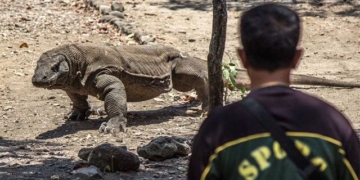Thanks to the careful monitoring by the homeowner, the rattlesnake catcher knew exactly where the rattlesnake was hiding, despite its excellent camouflage.
Rattlesnake Solutions, a company providing rattlesnake control services in Arizona, USA, posted a photo of a rocky slope on social media on November 12, challenging viewers to find the snake hiding in the image. However, the camouflage abilities of the Western Diamondback Rattlesnake (Crotalus atrox) left many people stumped.

The rattlesnake cleverly camouflaged on a rocky slope in Arizona, USA. (Photo: Rattlesnake Solutions)
Snake catcher Dave Holland was called in after the homeowner discovered an uninvited guest. “The snake was over a meter long and coiled under a large rock in front of a burrow of a rodent. The homeowner monitored the snake from a safe distance until I arrived. So we knew exactly where it was,” he recounted.
“The process of catching the snake was quick and easy. The only thing I was concerned about was that it might slip into the burrow and escape,” Holland said. He believed it was likely under the rock to cool its body in the hot weather. The animal was later released back into the wild.
The Western Diamondback Rattlesnake typically coils up in the shade to avoid the heat, according to the Arizona-Sonora Desert Museum. In winter, they burrow into dens to hibernate.
The challenge from Rattlesnake Solutions illustrates how easily people can pass by this dangerous creature without noticing it. The Nature Mapping Foundation reports that they bite hundreds of people each year. They will coil up and rattle vigorously when threatened. The rattle serves as a defensive signal and a warning to stay away.
The Western Diamondback Rattlesnake can strike at humans if it feels threatened, but it usually prefers hunting small mammals, birds, fish, and other reptiles, according to the Department of Zoology at the University of Michigan. In seconds, they can deliver a lethal bite by injecting venom into their prey.
The venom of the Western Diamondback Rattlesnake contains various toxic substances such as hemotoxins, cytotoxins, and myotoxins. Their bites can cause severe bleeding, both internally and externally. Swelling, bruising, blistering, and other skin lesions are also common. Without treatment, their bites can have a fatality rate of up to 20%.



















































